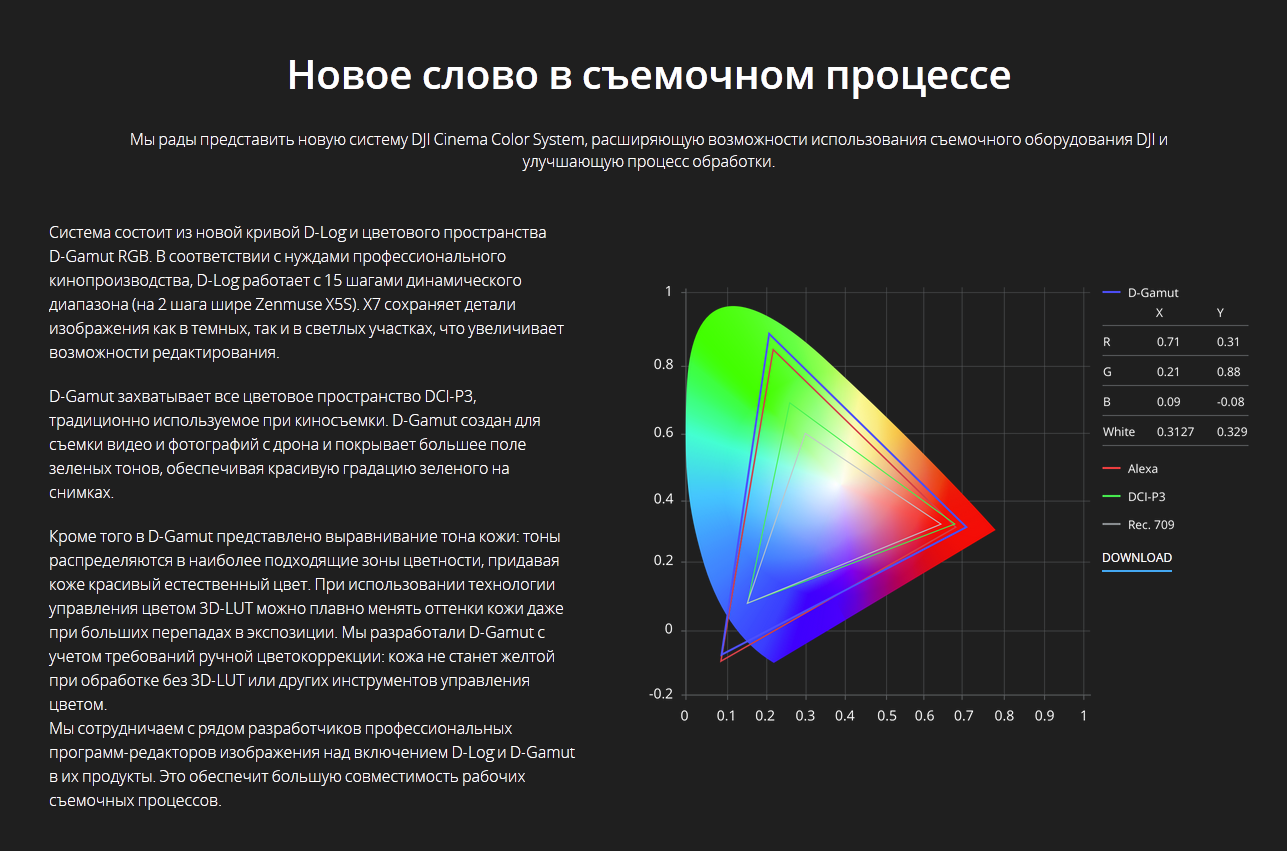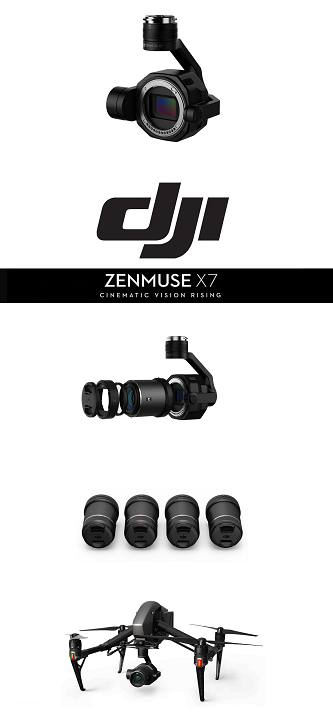
Introduction
On October 11th in California, DJI Innovations, as expected, announced the Zenmuse X7, a new compact Super-35 format cinematic camera. The new 24MP 14EV Cinematic Camera is capable of capturing uncompressed 35mm video in up to 6K quality. It features four different quick-release prime lenses made of lightweight carbon. While the camera is only compatible with the Inspire 2 drone, the developer promises compatibility with other DJI devices in the future.

Features
The list of the main features of the camera includes:
- 24MP APS-C matrix
- Super-35 sensor format
- Pixel size 3.91μm
- Dynamic range 14EV
- Sensor diagonal 26.6mm (for video)
- Working lens section 16.84mm
- 6K CinemaDNG / 5.2K Apple ProRes
- Signal to Noise Ratio (SNR) 46dB
- Tonal Range 9.41bit
- 4 × Lens DL-S / DL-mount: 16mm F2.8 / 24mm F2.8 / 35mm F2.8 / 50mm F2.8.
- CineCore 2.1 image processing system EI mode.
- New post-processing system - DJI Cinema Color System
- Camera weight with lens about 630 grams
About the product
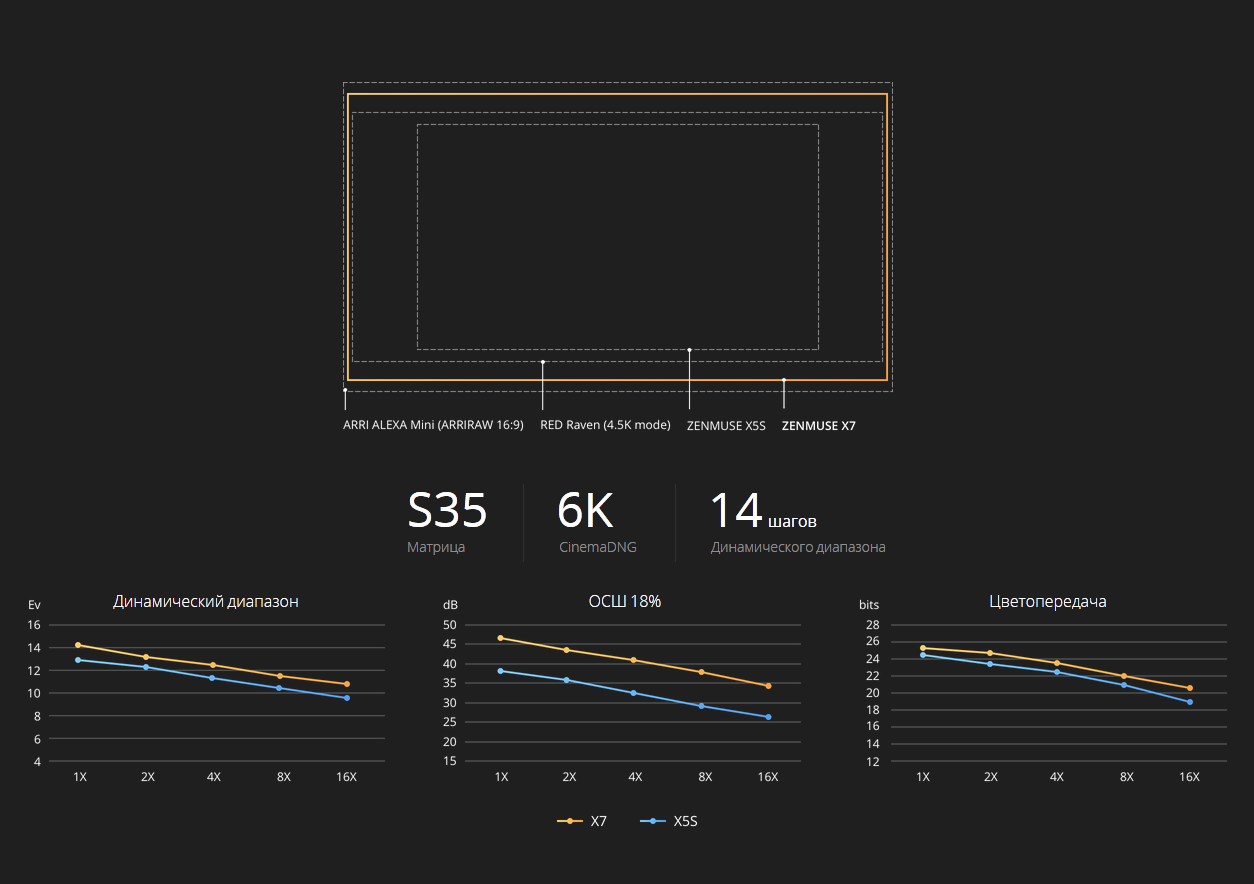
The Zenmuse X7 is a 24-megapixel cinematic camera with built-in stabilizer, capable of capturing 35mm high definition video. The camera has a stunning 14EV dynamic range (Zenmuse X5S has 12.8EV) and can record up to 6K @ 30fps in CinemaDNG and up to 5.2K @ 30fps in Apple ProRes 422HQ.
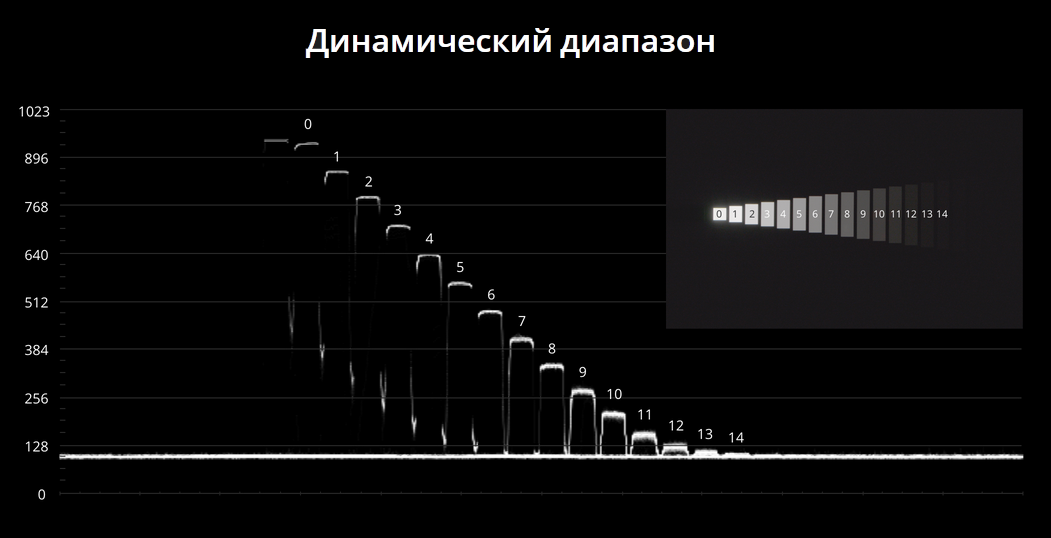
The camera supports the new CineCore 2.1 image processing system. Coupled with the new EI mode (enhances the quality of shooting depending on the level of sensitivity) allows you to easily process video captured in a resolution of 2704 × 1520p at 59.94 frames per second in the Apple ProRes 422 HQ format, thereby providing more options in post-processing material. In general, the transition from CineCore 2.0 (on the X5S camera) to the newer 2.1 system allowed to significantly reduce the presence of artifacts and noise in the frame, especially when shooting is carried out in low light conditions.
Camera video mode specification:
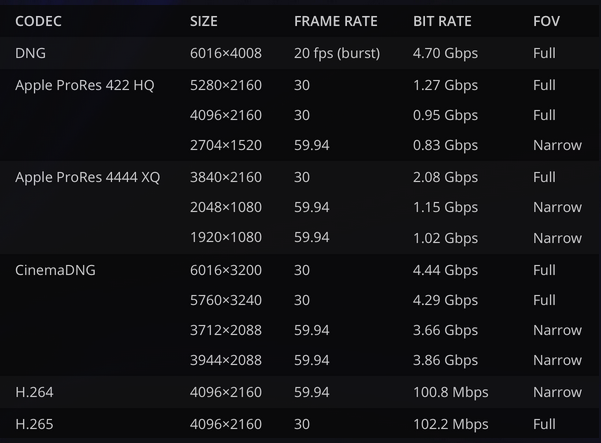
Building on the potential of the camera, the developer offered the consumer a new system that expands the use of DJI shooting equipment and improves the process material processing - DJI Cinema Color System.
The Zenmuse X7 supports continuous shooting of 20.8 megapixel DNG images and has a wide ISO range: Photo: 100 - 25600; Video: 100 - 1600 (with EI mode); 100 - 6400 (no EI mode). It should be noted that the sensor size for still photos is indicative: 23.5 × 15.7mm, the maximum sensor size for video is 23.5 × 12.5mm.
As a result of the application of the FSI-Cu technology in the creation of the matrix (it uses thinner connecting elements), it allowed the developers to install a more compact lens mount mechanism, without losing the quality of shooting. At the output, we get the flange distance of a DL-mount lens less than 17mm, which is about 1/3 the size of a PL mount. This compactness has significantly reduced the overall weight of the camera itself, after which the weight of the X7 together with the lens does not exceed 630 grams.
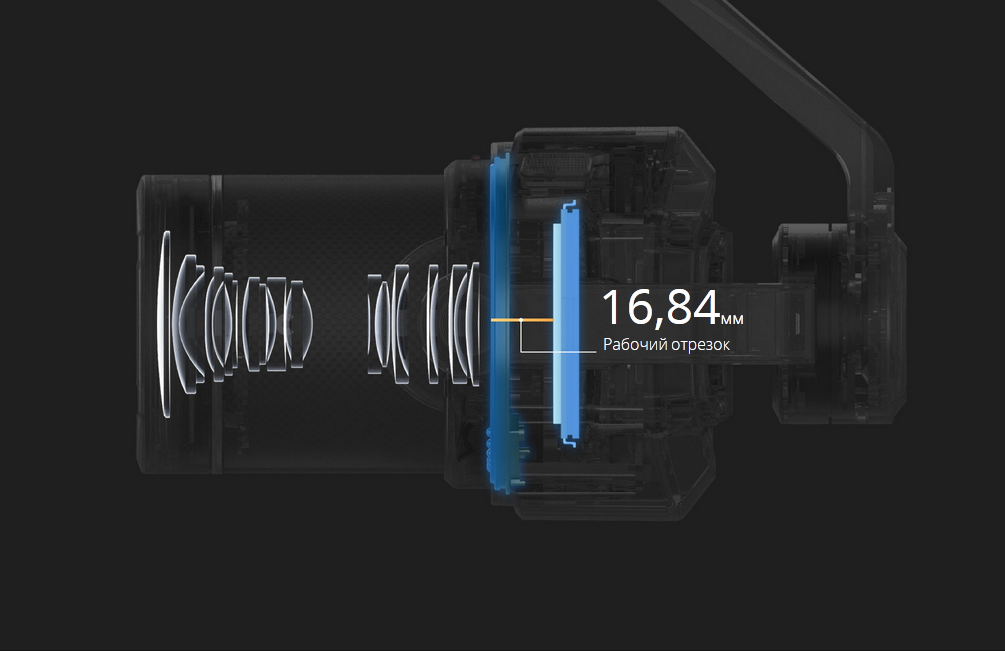
The weight of the Inspire 2 drone with the Zenmuse X7 camera installed on board is about 4 kg, while the functionality of the system is not inferior to more technological systems weighing up to 40 kg.
Appearance

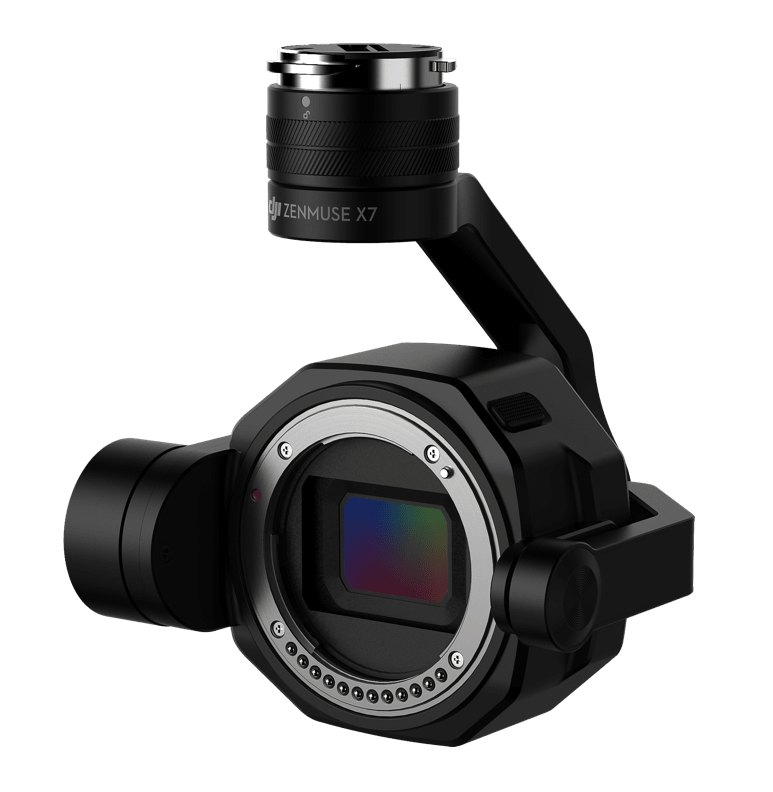
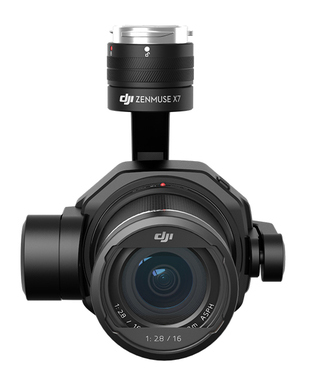
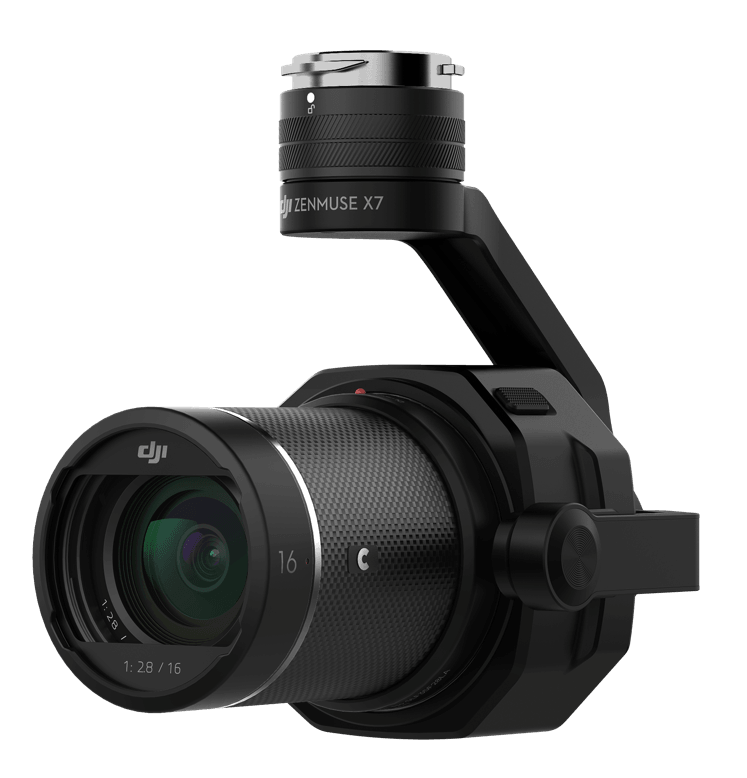
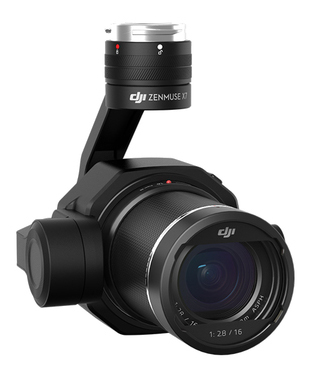
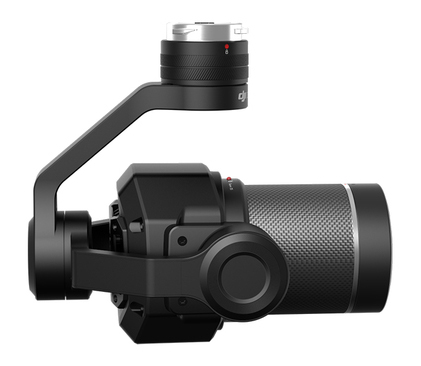

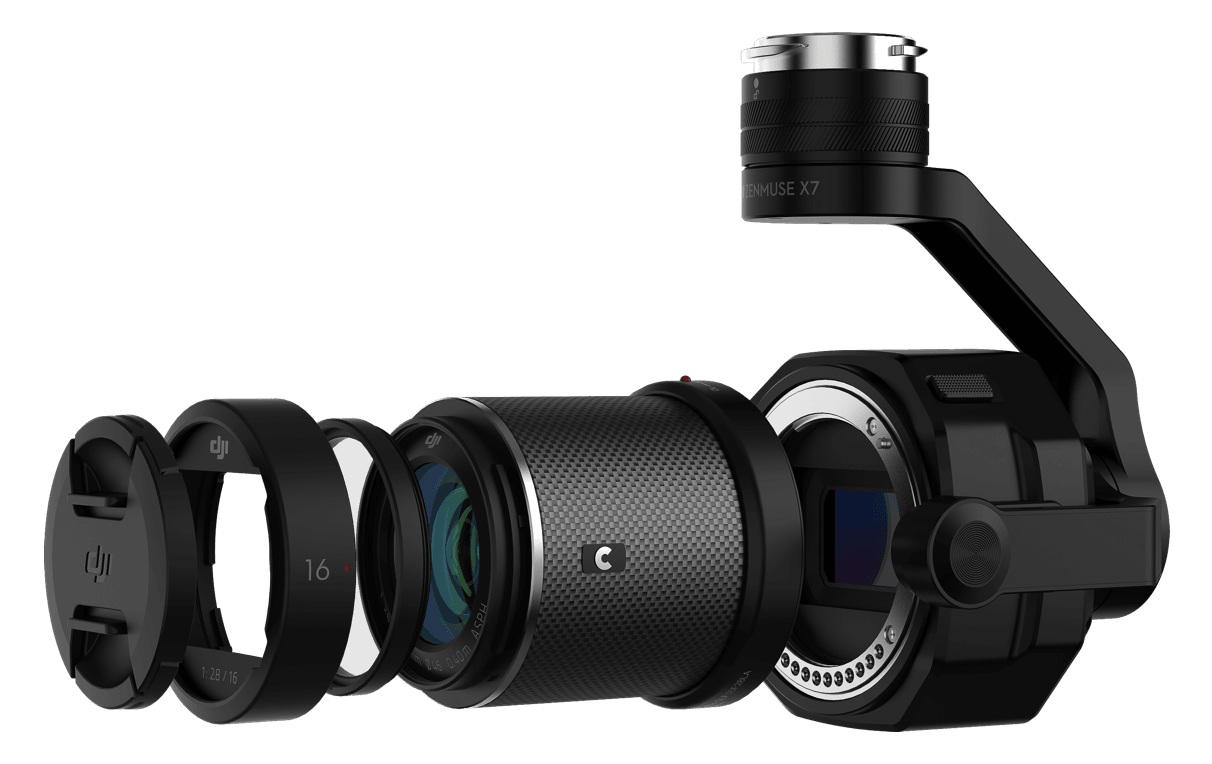
X7 Lenses

The Zenmuse X7 is currently only compatible with the four fixed focal length DL-mount lenses shown with a maximum aperture of F2.8. The 16mm lens has a built-in ND filter with a density of 4, but unlike the other three, it does not have a mechanical shutter, the speed of which is 1 / 1000s. The material of execution for all three is carbon fiber, weight is about 180g.
Lens specifications:
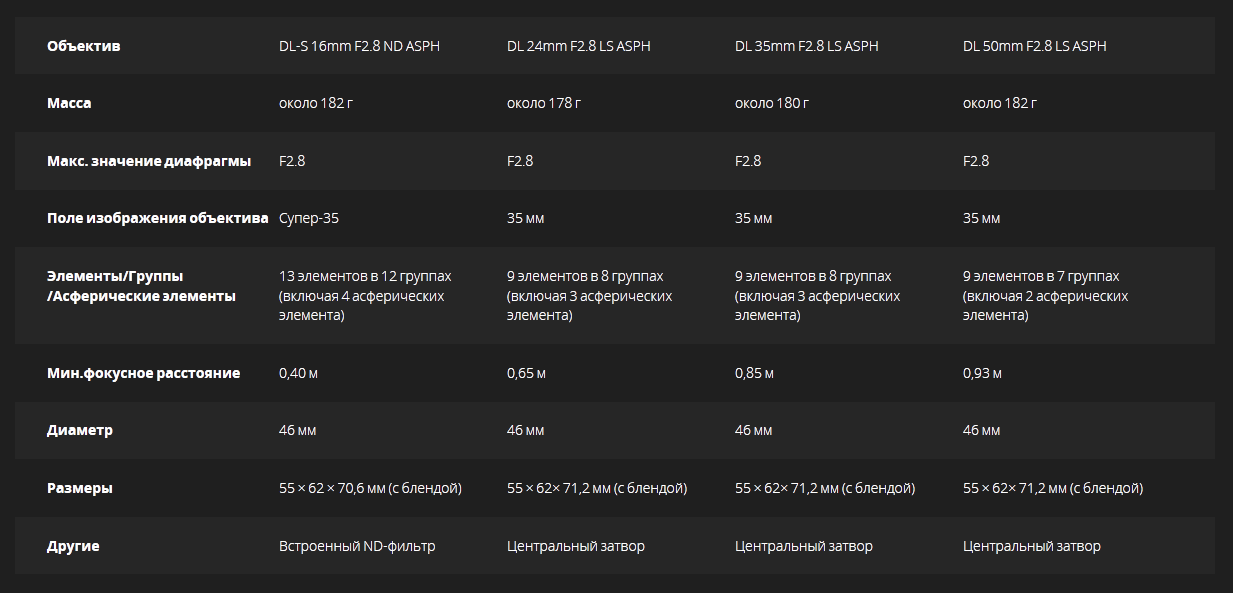
Specification
DJI DL 24mm F2.8 LS ASPH (with hood and balancing ring / filter)
DJI DL 35mm F2.8 LS ASPH (with hood and balancing ring / filter)
DJI DL 50mm F2.8 LS ASPH (with hood and balancing ring / filter)
SSD: RAW continuous shooting (3/5/7/10/14 / ∞ frames), up to 20 fps when using burst RAW shooting (shots are limited by storage capacity and battery level)
Mechanical shutter speed: 1/1000 - 8s (for DJ lens I DL-S 16mm F2.8 ND ASPH not supported)
Video
Aspect ratio 17: 9
Cinema- DNG: 6 K: 6016 × 3200 @ 23.976 / 24/25 / 29.97 / 30 fps, 12bit, full angle of view;
4 K DCI: 4096 × 2160 @ 23.976 / 24/25 / 29.97 / 30 fps, 12 bit full angle review;
3.9 K: 3944 × 2088 at 47.95 / 50 / 59.94 fps, 12 bit, narrow viewing angle;
ProRes: 4 K DCI: 4096 × 2160 at 23.976 / 24/25 / 29.97 / 30 fps, 10 bit, HQ, full angle of view;
2 K: 2048 × 1080 @ 47.95 / 50 / 59.94 fps, 10 bit, HQ / XQ, narrow angle;
H.264: 4 K DCI: 4096 × 2160 at 24/25/30 /48/50/59.94 fps;
H.265: 4 K DCI: 4096 × 2160 @ 24/25/30 fps
Aspect ratio 16: 9
CinemaDNG: 6 K: 5760 × 3240 at 23.976 / 24/25 / 29.97 / 30 fps, 12 bit, full angle of view;
4 K Ultra HD: 3840 × 2160 @ 23.976 / 24/25 / 29.97 / 30fps / s, 12 bit, full angle of view:
3.7 K: 3712 × 2088 @ 47.95 / 50 / 59.94 fps, 12 bit, narrow angle
ProRes: 4 K Ultra HD: 3840 × 2160 @ 23.976 /24/25/29.97 fps, 10-bit, HQ / XQ, full angle of view
2.7 K: 2704 × 1520 @ 47.95 / 50 / 59.94 fps, 10 bit, HQ, narrow viewing angle;
FHD: 1920 × 1080 @ 47.95 / 50 / 59.94 fps, 10-bit, HQ / XQ, narrow angle;
H.264: 4 K Ultra HD: 3840 × 2160 at 24/25/30/48/50 / 59.94 fps;
2.7 K: 2720 × 1530 @ 24/25/30/48/50 / 59.94 fps;
FHD: 1920 × 1080 @ 24/25/30/48/50 / 59.94 fps;
HD: 1280 × 720 @ 24/25/30/48/50 / 59.94 fps;
H.265: 4 K Ultra HD: 3840 × 2160 at 24/25/30 fps;
2.7 K: 2720 × 1530 @ 24/25/30/48/50 / 59.94 fps;
FHD: 1920 × 1080 @ 24/25/30/48/50 / 59.94 fps;
HD: 1280 × 720 @ 24/25/30/48/50 / 59.94 fps;
Aspect ratio 2.44: 1
ProRes: 5.2 K: 5280 × 2160 @ 23.976 / 24 /25/29.97/30 fps, 10 bit, HQ, full angle of view;
H.264 / H.265: 4 K Ultra HD: 3840 × 1572 @ 30fps, FOV
Temperature
User guide.
Price
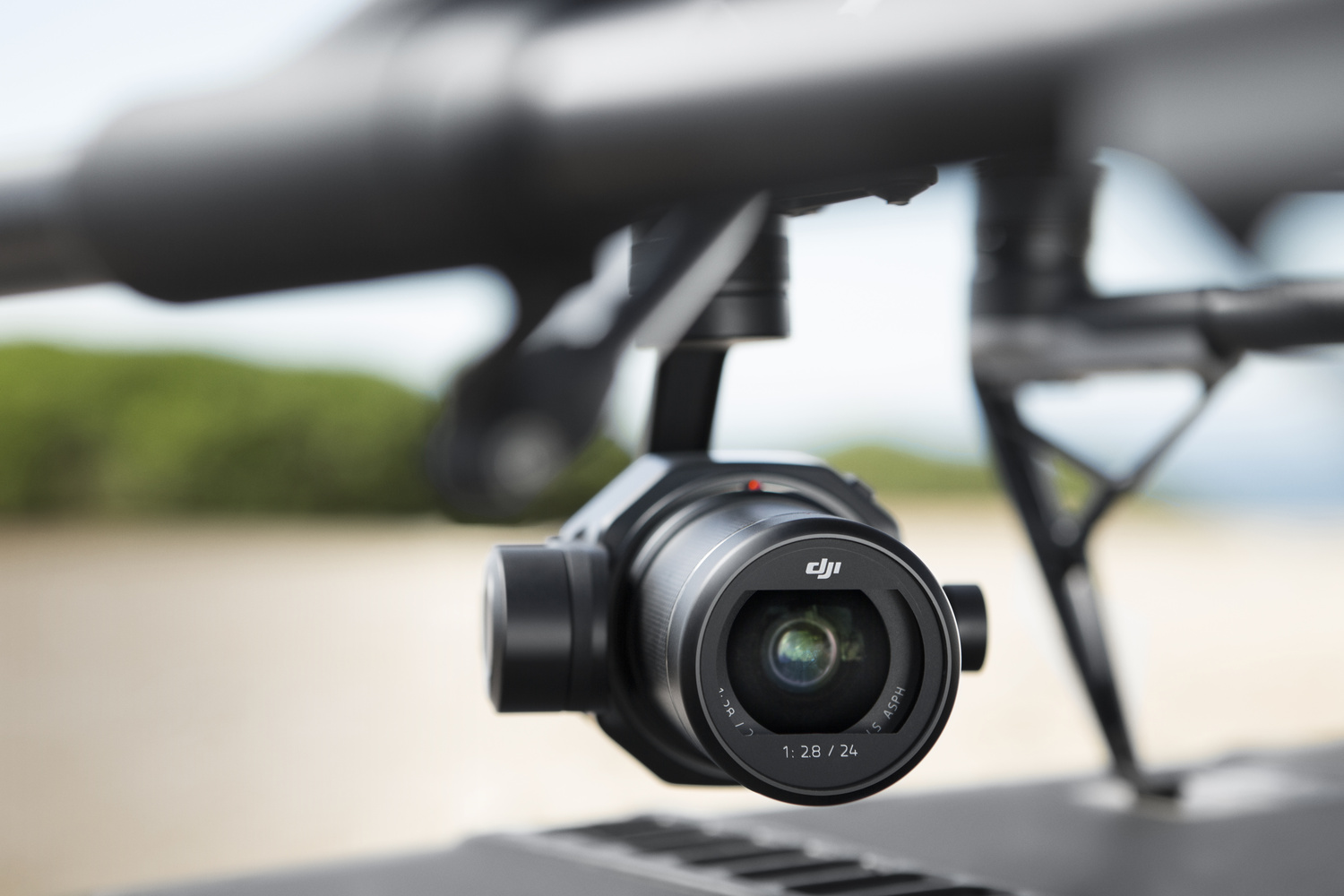
A camera without a lens will cost the consumer $ 2699. Lenses: 16/24 / 35mm (each) priced at $ 1299. 50mm lens - $ 1199. You can purchase the entire range of lenses in one set for - $ 4299, which will save you $ 797.
Conclusion
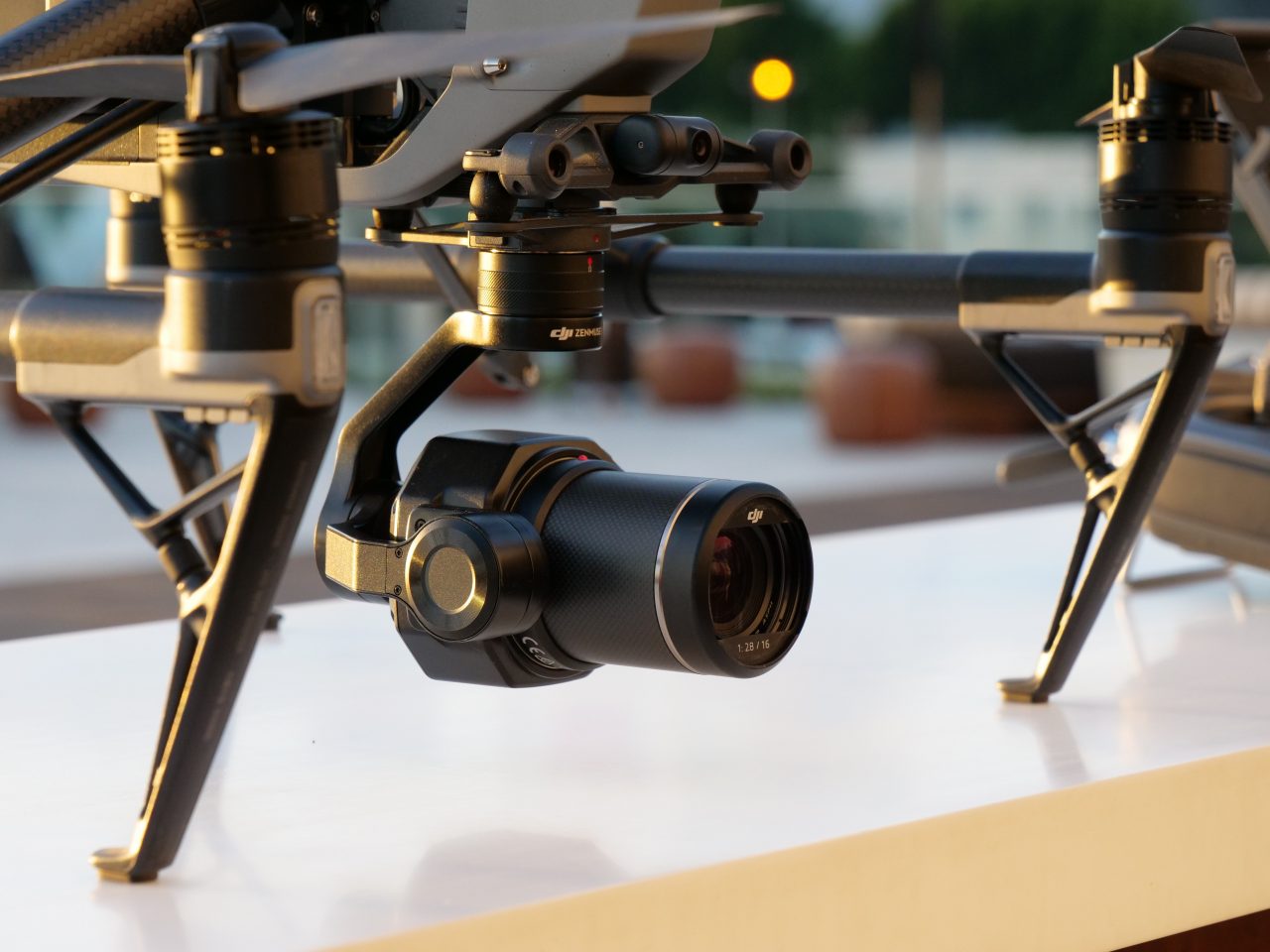
The Zenmuse X7 is the undoubted breakthrough in professional video filming. The potential of the complex, consisting of the Inspire 2 drone and the Zenmuse X7 cinematic camera, is so heavy that it can rise on a par with high-end professional equipment, clearly highlighting its economic efficiency. We also note the high-quality materials of Zenmuse X7, coupled with modern technologies, which made it possible to fit the cinematographic capabilities of today's professional cameras into miniature dimensions, outperforming the latter in weight. Hopefully other DJI X7-compatible devices will be available soon, allowing you to shoot from the air as well as from the ground.
FAQ
Q: Is it possible to mount Zenmuse X7 on drones other than Inspire 2, or use the camera separately?
A: Not at this time, but it will be compatible with other DJI products in the future.
Q: Is the Zenmuse X7 compatible with the Inspire 1?
A: No
Q: What are the main differences between Zenmuse X7 and Zenmuse X5S?
О: X7 has a Super-35 format matrix and DL-mount in its arsenal. Compatible with 4 lenses (16, 24, 35 and 50mm). The X5S features a 4: 3 micro matrix and supports eight Pro lenses with standard M4 / 3 mount. Some X5S lenses require a balance ring.
Q: How is the DL mount better than others?
A: Dramatically reduces the size and weight of the camera, ensuring high quality footage. The flange is only 16.84mm.
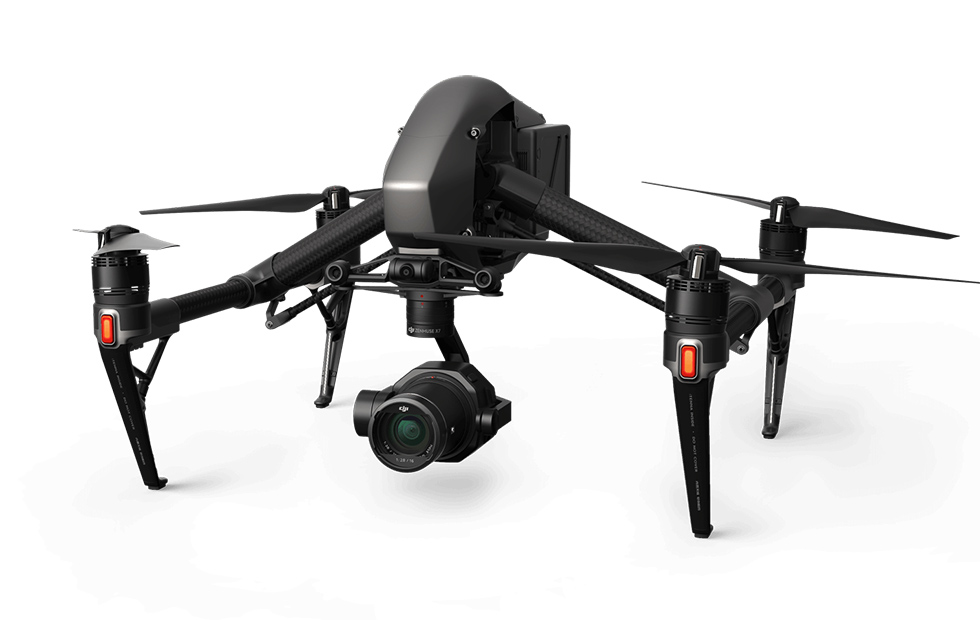
Q: Which lenses are compatible with the X7?
A: At the moment, the X7 can only work with four lenses that were introduced with the camera - these are fixed focal length DL-mount lenses with a maximum aperture of F2.8.
Q: What is the difference between DL-S lens and DL lens?
M: Max. the size of the matrix with which the lens can work. Super-35 format is available for DL-S lens, full matrix format is available for DL lenses.
Q: Is it possible to use third-party filters on the lenses of the X7?
A: Yes. Any filters with a diameter of 46mm, weighing from 10-12 grams and a thickness of no more than 4.4mm (without thread) are suitable for X7 lenses.
Q: What is the best storage device to use when using the X7 camera with the Inspire 2 drone?
A: Micro SD card and DJI CINESSD. For simple, not complex shooting, one Micro SD card will be enough. For more complex, high-quality work that requires special video formats, you must use the CINESSD in conjunction with Micro SD. It is not possible to use the CINESSD without a Micro SD card.
Video
Video captured with the Zenmuse X7 camera and the Inspire 2.
.